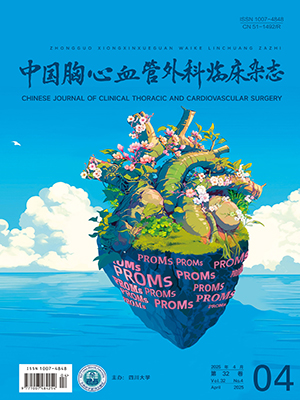| 1. |
顾燕, 金梅, 丁文虹, 等. 儿童先天性主动脉瓣狭窄经皮主动脉瓣球囊成形术的近中期随访研究. 中国医药, 2018, 13(11): 1637-1641.
|
| 2. |
褚恒, 唐杨烽, 徐志云, 等. 儿童主动脉瓣置换术近远期疗效分析. 国际心血管病杂志, 2017, 44(4): 236-240.
|
| 3. |
贾兵. 自体心包修复儿童主动脉瓣病变. 中国循环杂志, 2015, (z1): 115.
|
| 4. |
金晶, 华正东, 曾祥军, 等. 单个主动脉瓣叶牛心包置换术治疗儿童室间隔缺损合并主动脉瓣反流. 中国胸心血管外科临床杂志, 2014, 21(2): 216-219.
|
| 5. |
张善通, 陈张根, 贾兵. 小儿胸心外科学. 上海: 上海科学技术文献出版社, 2007. 349-397.
|
| 6. |
胡志德. AME 统计学专栏|手把手教你如何解读生存曲线. 临床与病理杂志, 2015, 35(3): 349-352.
|
| 7. |
Nishimura RA, Otto CM, Bonow RO, et al. AHA/ACC guideline for the management of patients with valvular heart disease: executive summary: a report of the American College of Cardiology/American Heart Association Task Force on Practice Guidelines. Circulation, 2014, 129(23): 2440-2492.
|
| 8. |
许迪. 主动脉瓣狭窄程度的超声评估及分级. 厦门: 2018 海峡两岸医药卫生交流与合作会议暨第十届海峡两岸超声医学高端论坛论文集, 2018. 17-41.
|
| 9. |
Atik SU, Eroğlu AG, Çinar B, et al. Comparison of balloon dilatation and surgical valvuloplasty in non-critical congenital aortic valvular stenosis at long-term follow-up. Pediatr Cardiol, 2018, 39(8): 1554-1560.
|
| 10. |
朱贵军, 陈兴澎, 王亚宏, 等. 儿童主动脉瓣病变的外科治疗策略. 中华小儿外科杂志, 2017, 38(3): 178-181.
|
| 11. |
王坤, 贾兵. 儿童主动脉瓣疾病手术治疗进展. 中华外科杂志, 2018, 56(6): 414-417.
|
| 12. |
Ozaki S, Kawase I, Yamashita H, et al. Aortic valve reconstruction using self-developed aortic valve plasty system in aortic valve disease. Interact Cardiovasc Thorac Surg, 2011, 12(4): 550-553.
|
| 13. |
单亚平, 贾兵, 张惠锋, 等. 自体心包修复儿童主动脉瓣狭窄 9 例病例系列报告. 中国循证儿科杂志, 2017, 12(4): 268-272.
|
| 14. |
Mokhles MM, Rizopoulos D, Andrinopoulou ER, et al. Autograft and pulmonary allograft performance in the second post-operative decade after the Ross procedure: insights from the Rotterdam Prospective Cohort Study. Eur Heart J, 2012, 33(17): 2213-2224.
|
| 15. |
Ross DN. Replacement of aortic and mitral valves with a pulmonary autograft. Lancet, 1967, 2(7523): 956-958.
|
| 16. |
甘辉立, 张健群, 李继勇, 等. 应用 ROSS 手术治疗儿童主动脉瓣病变的研究. 中华小儿外科杂志, 2007, 28(8): 397-400.
|




